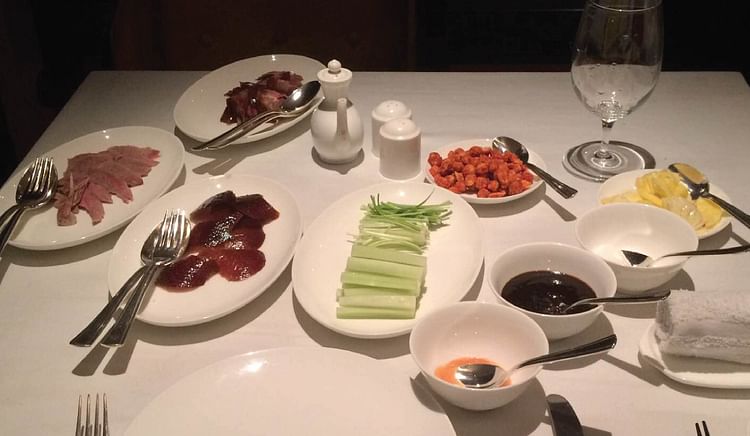In Pursuit of Peking Duck: Part 1
Origins and Legends of the Bird from Beijing
25 Sep, 2016 by Amit Patnaik
A popular internet saying posits that the two things one dare not miss when visiting Beijing are: 1) trekking on the Great Wall of China; and 2) dining on a Peking duck. Although I have not been to Beijing yet, I had the great pleasure of witnessing the bird being carved on my table recently and, as far web gospels go, I find this one compellingly believable.
An oversimplified comparison with tandoori chicken tempts me; after all, both fowls have become the dining superstars of their cuisine. However, with no disrespect to the national bird of Delhi, it stands no chance against the Peking duck, even when there is no Kung Fu involved!
It is not hard to understand why. Consider that while tandoori chicken is a perennial staple on the menu of any sort of Indian restaurant (North Indian/Malvani/Chettinadu – tandoori chicken will always sell), an authentic Peking duck is hardly as ubiquitous as noodles or dumplings. In the vast, vast world of bastardised Chinese takeouts or dim sum houses, the ceremonial Peking duck experience remains a staunch vestige of oriental ostentation.
History and Legends:
Some legends of the duck’s origin point to the arrival of European roasting techniques with Marco Polo (no mention in the eponymous, full-HD and lurid Netflix series either!), but I side with historians who date it to the small, black-feathered Nanjing duck roasted in the ovens of the North and South dynasty (5th century). That tradition remained until the Southern Song Dynasty (12th century) was thrown out by Yuan Mongols. The Great Khan moved the capital of his new empire to Beijing (then Khanbaliq) and the dish finds mention as ‘shaoyazi’ (which translates into ‘burning duck’) in the 14th century work of Imperial Kitchen Inspector Hui Sihui, the Yinshan Zhengyao (a dietary manual and cookbook for the Emperor and the royal court).
By the Ming Dynasty (who moved their capital from Nanjing to Beijing, then popularly called Peking), the dish had made its way out of the royal kitchens and the black Nanjing birds fell out of favour, being replaced by their white Beijing cousins. Poets of that era have waxed about the duck at the Bianyi Fang restaurant (established in the 15th century and still in operation) in Qianmen area of Beijing. Bianyi Fang (which means ‘comfortable and convenient’) employs an older cooking method called menlu, where convection heat is used to roast the bird. Sorghum stalks are burned to heat the oven before placing the duck inside to cook from the radiant heat.
Peking duck’s popularity continued throughout the Qing Dynasty (17th–20th centuries) with a modern version perhaps reaching its zenith at the Quanjude Restaurant. This restaurant was sstablished in 1864 (also in the Qianmen area of Beijing, though more ambitiously named to mean ‘perfection, union and benevolence’) by Yang Quanren. Quanjude Restaurant bought in former chefs from the imperial kitchen and, with them, the Guanlu method of cooking – the duck is hung inside an open oven and heated by smoke-less hardwood fuel such as applewood.
Now perhaps the world’s most famous restaurant to serve the Peking duck, Quanjude sells over two million Peking ducks in a year. It has also played host to world leaders like George Bush Sr., Fidel Castro, Yasser Arafat, Kim Jong II and, very famously, Henry Kissinger.
A story goes that while on a ‘secret’ trip to the People’s Republic of China in 1971, Kissinger’s discussions with the Chinese delegation reached a stalemate when both parties broke for lunch. Premier Zhou Enlai took the opportunity to engage in some ‘duck-diplomacy’, charming Kissinger with Quanjude’s Peking duck at the Great Hall of the People (allegedly, personally teaching him how to roll the pancake). When talks resumed after lunch, the duck is said to have paved the way for President Nixon’s visit next year and US’s rapprochement for China in the ’70s (I did not make the story up, so do not shoot me if it sounds bogus).
Well, that is not the end of our tale though. Stay tuned for the next Eazytrend to find out what goes into making a Peking duck and where to find the best in Chennai!

